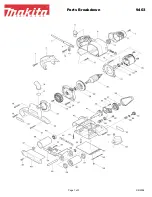
2
WARNING LABEL IDENTIFICATION
FAILURE TO OBSERVE THE FOLLOWING WARNINGS COULD RESULT IN INJURY.
Always wear eye protection
when operating or perform-
ing maintenance on this
tool.
WARNING
WARNING
Always wear hearing
protection when operating
this tool.
Always turn off the air sup-
ply and disconnect the air
supply hose before install-
ing, removing or adjusting
any accessory on this tool,
or before performing any
maintenance on this tool.
WARNING
Air powered tools can vibrate
in use. Vibration, repetitive
motions or uncomfortable po-
sitions may be harmful to your
hands and arms. Stop using
any tool if discomfort, tingling
feeling or pain occurs. Seek
medical advice before resum-
ing use.
WARNING
Do not carry the tool by
the hose.
WARNING
WARNING
Do not use damaged, frayed
or deteriorated air hoses
and fittings.
WARNING
Keep body stance balanced
and firm. Do not overreach
when operating this tool.
WARNING
Operate at 90 psig (6.2 bar/
620 kPa) Maximum air pressure.
90 psig
(6.2bar/620kPa)
SANDER SPECIFIC WARNINGS
•
These Sanders will operate at the free speed specified
on the nameplate if the air supply line furnishes
90 psig (6.2 bar/620 kPa) air pressure at the tool.
Operation at higher air pressure will result in
excessive speed.
•
Use only a sanding pad, buffing wheel or polishing
bonnet with these tools. Do not use any grinding
wheel, bur or metal removing accessory with these
tools. Never use an accessory having a maximum
operating speed less than the free speed of the Sander
in which it is being used.
•
When using a pad having a shank, insert the shank to
full depth in the collet. When using a pad on a
threaded arbor, make certain the flange nut is
tightened securely. Check the tightness of the collet
nut or flange nut before operating a Sander to make
certain it will not loosen during operation.
•
Do not attempt to disassemble the Controller. The
Controller is available only as a unit and is guaranteed
for the life of the tool if it is not abused.



































